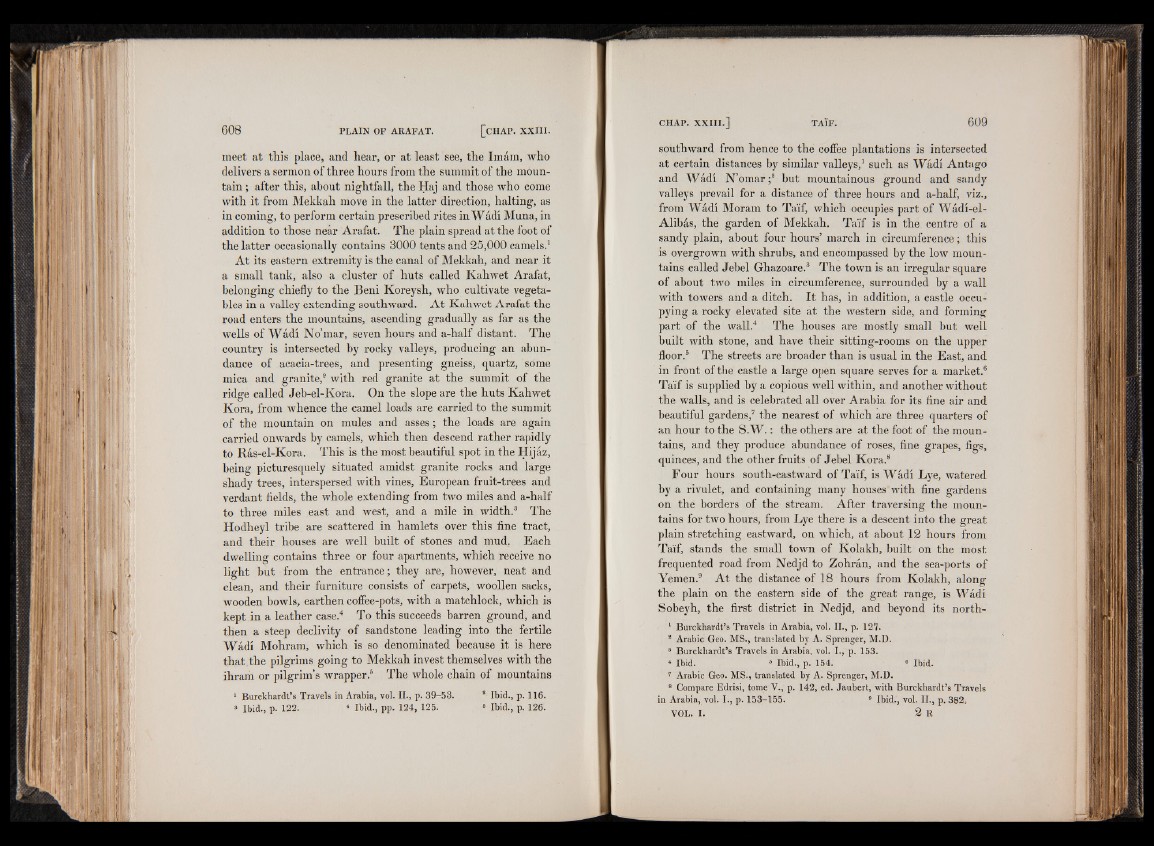
meet at this place, and hear, or at least see, the Imam, who
delivers a sermon of three hours from the summit of the mountain
; after this, about nightfall, the Haj and those who come
with it from Mekkah move in the latter direction, halting, as
in coming, to perform certain prescribed rites in Wadi Muna, in
addition to those near Arafat. The plain spread at the foot of
the latter occasionally contains 3000 tents and 25,000 camels.1
At its eastern extremity is the canal of Mekkah, and near it
a small tank, also a cluster of huts called Kahwet Arafat,
belonging chiefly to the Beni Koreysh, who cultivate vegetables
in a valley extending southward. At Kahwet Arafat the
road enters the mountains, ascending gradually as far as the
wells of Wadi No’mar, seven hours and a-half distant. The
country is intersected by rocky valleys, producing an abundance
of acacia-trees, and presenting gneiss, quartz, some
mica and granite,2 with red granite at the summit of the
ridge called Jeb-el-Kora. On the slope are the huts Kahwet
Kora, from whence the camel loads are carried to the summit
of the mountain on mules and asses; the loads are again
carried onwards by camels, which then descend rather rapidly
to Ras-el-Kora. This is the most beautiful spot in the Hijaz,
being picturesquely situated amidst granite rocks and large
shady trees, interspersed with vines, European fruit-trees and
verdant fields, the whole extending from two miles and a-half
to three miles east and west, and a mile in width.3 The
Hodheyl tribe are scattered in hamlets over this fine tract,
and their houses are well built of stones and mud, Each
dwelling contains three or four apartments, which receive no
light but from the entrance; they are, however, neat and
clean, and their furniture consists of carpets, woollen sacks,
wooden bowls, earthen coffee-pots, with a matchlock, which is
kept in a leather case.4 To this succeeds barren ground, and
then a steep declivity of sandstone leading into the fertile
Wadi Mohram, which is so denominated because it is here
that the pilgrims going to Mekkah invest themselves with the
ihram or pilgrim’s wrapper.6 The whole chain of mountains
southward from hence to the coffee plantations is intersected
at certain distances by similar valleys,1 such as Wadi Antago
and Wadi N’omar ;2 but mountainous ground and sandy
valleys prevail for a distance of three hours and a-half, viz.,
from Wadi Moram to Ta'if, which occupies part of Wadi-el-
Alibas, the garden of Mekkah. Ta'if is in the centre of a
sandy plain, about four hours’ march in circumference; this
is overgrown with shrubs, and encompassed by the low mountains
called Jebel Ghazoare.3 The town is an irregular square
of about two miles in circumference, surrounded by a wall
with towers and a ditch. It has, in addition, a castle occupying
a rocky elevated site at the western side, and forming
part of the wall.4 The houses are mostly small but well
built with stone, and have their sitting-rooms on the upper
floor.5 The streets are broader than is usual in the East, and
in front of the castle a large open square serves for a market.6
Ta'if is supplied by a copious well within, and another without
the walls, and is celebrated all over Arabia for its fine air and
beautiful gardens,7 the nearest of which are three quarters of
an hour to the S .W .: the others are at the foot of the mountains,
and they produce abundance of roses, fine grapes, figs,
quinces, and the other fruits of Jebel Kora.8
Four hours south-eastward of Ta'if, is Wadi Lye, watered
by a rivulet, and containing many houses with fine gardens
on the borders of the stream. After traversing the mountains
for two hours, from Lye there is a descent into the great
plain stretching eastward, on which, at about 12 hours from
Ta'if, stands the small town of Kolakli, built on the most
frequented road from Nedjd to Zohran, and the sea-ports of
Yemen.9 At the distance of 18 hours from Kolakh, along
the plain on the eastern side of the great range, is Wadi
Sobeyh, the first district in Nedjd, and beyond its north-
1 Burckhardt’s Travels in Arabia, vol. II., p. 12*7.
2 Arabic Geo. MS., translated by A. Sprenger, M.D.
8 Burckhardt’s Travels in Arabia, vol. I., p. 153.
4 Ibid. 5 Ibid., p. 154. 6 Ibid.
1 Arabic Geo. MS., translated by A. Sprenger, M.D.
8 Compare Edrisi, tome V., p. 142, ed. Jaubert, with Burckhardt’s Travels
in Arabia, vol. I., p. 153-155. 2 Ibid., vol. II., p. 382..
VOL. I . 2 R